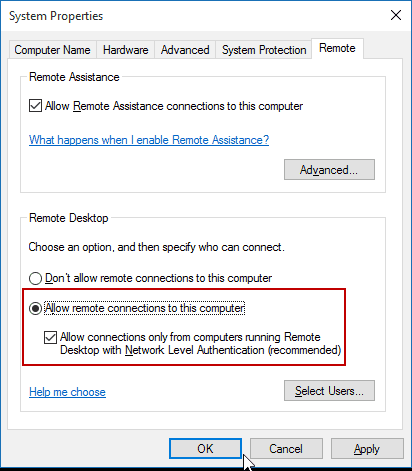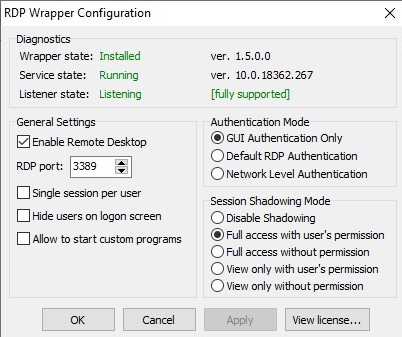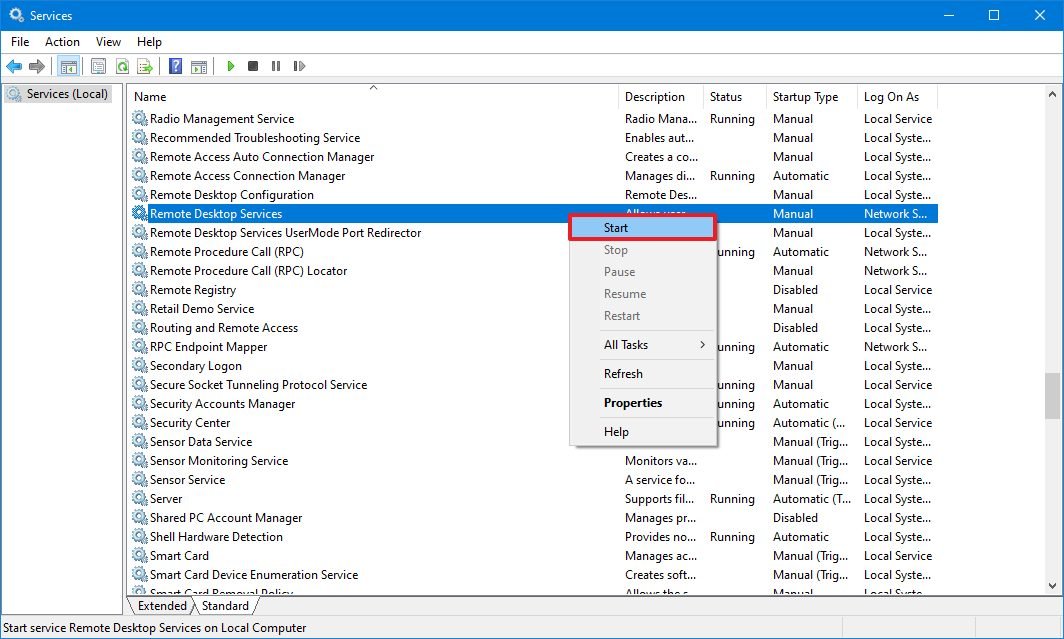-->
- Remote Desktop Client Windows 10
- Remote Desktop Services Windows 10
- Remote Desktop Services Manager Windows 10
- Remote Desktop Services Windows Xp
- Remote Desktop Services Download
Remote Desktop Services (RDS) built on Windows Server 2016 is a virtualization platform enabling a wide range of customer scenarios. Improvements in the overall RDS solution incorporates the work done by both the Remote Desktop team and other technology partners at Microsoft. The following scenarios and technologies are new or improved in Windows Server 2016.
Also be sure to check out our session from Ignite 2016: Harness RDS improvements in Windows Server 2016. In this video, the product team reviews all of the new and improved features in Remote Desktop Services, including vGPU support.
App Compatibility - Windows Server 2016 and Windows 10
Built on the same foundation of Windows 10, Windows Server 2016 not only has the same look and feel you expect out of a desktop but can also run many of the same applications. Pairing Windows Server 2016 with the graphics capabilities (below) gives you an environment for all users to be productive.
For Windows Server 2012 R2 Remote Desktop Services updates, see Available Updates for Remote Desktop Services in Windows Server 2012 R2. Addresses an issue that causes a Remote Desktop Session Host server to occasionally stop responding during login. Applies to: Windows 10, Windows 10 IoT Enterprise, and Windows 7 You can use the Remote Desktop client for Windows Desktop to access Windows apps and desktops remotely from a different Windows device.
Remote Desktop Client Windows 10
Azure SQL Database - the new database for your highly available environment
The RD Connection Broker is able to store all of the deployment information (like connection states and user/host mappings) in a shared SQL database, such as an Azure SQL database. Ditch the SQL Server Always On Availability Group deployment manual, grab the connection string to the Azure SQL database, and start using your highly available environment.
Additional information: Use Azure SQL DB for your Remote Desktop Connection Broker high availability environment
Graphics - solving graphics needs across various scenarios
Thanks to Hyper-V's Discrete Device Assignment, you can now map GPUs on a host machine directly to a VM to be consumed by its GPU-requiring applications. Improvements have also been made in RemoteFX vGPU, including support for OpenGL 4.4, OpenCL 1.1, 4k resolution, and Windows Server virtual machines.

Additional information: Discrete Device Assignment
RD Connection Broker - improved connection handling during logon storms
Adobe acrobat pro for macbook pro. With improved connection handling, the RD Connection Broker is now able to handle over 10,000 concurrent logon requests, sometimes seen during 'logon storms'. The improved RD Connection Broker also makes maintenance of the deployment simpler by being able to more quickly add servers back into the environment.
Additional information: Improved Remote Desktop Connection Broker Performance
RDP 10 - new capabilities built into the protocol
RDP 10 now uses the H.264/AVC 444 codec, appropriately optimizing across both video and text. With this release, pen remoting is also supported. With these capabilities, your remote sessions start to feel even more like a local session.
Additional information: RDP 10 AVC/H.264 improvements in Windows 10 and Windows Server 2016
Personal session desktops - providing individual desktops to any end-user
Personal session desktops is a new way to have your own personal desktop hosted for you in the cloud. Administrative privileges and dedicated session hosts removes the complexity of hosting environments where users want to manage the desktop like it's their own.
Additional information: Personal Session Desktops
-->Applies to
- Windows 10
Describes the best practices, location, values, policy management, and security considerations for the Allow log on through Remote Desktop Services security policy setting.
Reference
This policy setting determines which users or groups can access the logon screen of a remote device through a Remote Desktop Services connection. It is possible for a user to establish a Remote Desktop Services connection to a particular server but not be able to log on to the console of that same server.
Constant: SeRemoteInteractiveLogonRight
Possible values

- User-defined list of accounts
- Not Defined
Best practices
- To control who can open a Remote Desktop Services connection and log on to the device, add users to or remove users from the Remote Desktop Users group.

Location
Computer ConfigurationWindows SettingsSecurity SettingsLocal PoliciesUser Rights Assignment
Default values
By default, members of the Administrators group have this right on domain controllers, workstations, and servers. The Remote Desktops Users group also has this right on workstations and servers.The following table lists the actual and effective default policy values. Default values are also listed on the policy's property page.
| Server type or GPO | Default value |
|---|---|
| Default Domain Policy | Not Defined |
| Default Domain Controller Policy | Not Defined |
| Domain Controller Local Security Policy | Administrators |
| Stand-Alone Server Default Settings | Administrators Remote Desktop Users |
| Domain Controller Effective Default Settings | Administrators |
| Member Server Effective Default Settings | Administrators Remote Desktop Users |
| Client Computer Effective Default Settings | Administrators Remote Desktop Users |
Policy management
This section describes different features and tools available to help you manage this policy.
Group Policy
To use Remote Desktop Services to successfully log on to a remote device, the user or group must be a member of the Remote Desktop Users or Administrators group and be granted the Allow log on through Remote Desktop Services right. It is possible for a user to establish an Remote Desktop Services session to a particular server, but not be able to log on to the console of that same server.
To exclude users or groups, you can assign the Deny log on through Remote Desktop Services user right to those users or groups. However, be careful when you use this method because you could create conflicts for legitimate users or groups that have been allowed access through the Allow log on through Remote Desktop Services user right.
For more information, see Deny log on through Remote Desktop Services.
A restart of the device is not required for this policy setting to be effective.
Any change to the user rights assignment for an account becomes effective the next time the owner of the account logs on.
Group Policy settings are applied through GPOs in the following order, which will overwrite settings on the local computer at the next Group Policy update:
- Local policy settings
- Site policy settings
- Domain policy settings
- OU policy settings
Security considerations
Opacity hotkey after effects. This section describes how an attacker might exploit a feature or its configuration, how to implement the countermeasure, and the possible negative consequences of countermeasure implementation.
Remote Desktop Services Windows 10

Vulnerability
Additional information: Discrete Device Assignment
RD Connection Broker - improved connection handling during logon storms
Adobe acrobat pro for macbook pro. With improved connection handling, the RD Connection Broker is now able to handle over 10,000 concurrent logon requests, sometimes seen during 'logon storms'. The improved RD Connection Broker also makes maintenance of the deployment simpler by being able to more quickly add servers back into the environment.
Additional information: Improved Remote Desktop Connection Broker Performance
RDP 10 - new capabilities built into the protocol
RDP 10 now uses the H.264/AVC 444 codec, appropriately optimizing across both video and text. With this release, pen remoting is also supported. With these capabilities, your remote sessions start to feel even more like a local session.
Additional information: RDP 10 AVC/H.264 improvements in Windows 10 and Windows Server 2016
Personal session desktops - providing individual desktops to any end-user
Personal session desktops is a new way to have your own personal desktop hosted for you in the cloud. Administrative privileges and dedicated session hosts removes the complexity of hosting environments where users want to manage the desktop like it's their own.
Additional information: Personal Session Desktops
-->Applies to
- Windows 10
Describes the best practices, location, values, policy management, and security considerations for the Allow log on through Remote Desktop Services security policy setting.
Reference
This policy setting determines which users or groups can access the logon screen of a remote device through a Remote Desktop Services connection. It is possible for a user to establish a Remote Desktop Services connection to a particular server but not be able to log on to the console of that same server.
Constant: SeRemoteInteractiveLogonRight
Possible values
- User-defined list of accounts
- Not Defined
Best practices
- To control who can open a Remote Desktop Services connection and log on to the device, add users to or remove users from the Remote Desktop Users group.
Location
Computer ConfigurationWindows SettingsSecurity SettingsLocal PoliciesUser Rights Assignment
Default values
By default, members of the Administrators group have this right on domain controllers, workstations, and servers. The Remote Desktops Users group also has this right on workstations and servers.The following table lists the actual and effective default policy values. Default values are also listed on the policy's property page.
| Server type or GPO | Default value |
|---|---|
| Default Domain Policy | Not Defined |
| Default Domain Controller Policy | Not Defined |
| Domain Controller Local Security Policy | Administrators |
| Stand-Alone Server Default Settings | Administrators Remote Desktop Users |
| Domain Controller Effective Default Settings | Administrators |
| Member Server Effective Default Settings | Administrators Remote Desktop Users |
| Client Computer Effective Default Settings | Administrators Remote Desktop Users |
Policy management
This section describes different features and tools available to help you manage this policy.
Group Policy
To use Remote Desktop Services to successfully log on to a remote device, the user or group must be a member of the Remote Desktop Users or Administrators group and be granted the Allow log on through Remote Desktop Services right. It is possible for a user to establish an Remote Desktop Services session to a particular server, but not be able to log on to the console of that same server.
To exclude users or groups, you can assign the Deny log on through Remote Desktop Services user right to those users or groups. However, be careful when you use this method because you could create conflicts for legitimate users or groups that have been allowed access through the Allow log on through Remote Desktop Services user right.
For more information, see Deny log on through Remote Desktop Services.
A restart of the device is not required for this policy setting to be effective.
Any change to the user rights assignment for an account becomes effective the next time the owner of the account logs on.
Group Policy settings are applied through GPOs in the following order, which will overwrite settings on the local computer at the next Group Policy update:
- Local policy settings
- Site policy settings
- Domain policy settings
- OU policy settings
Security considerations
Opacity hotkey after effects. This section describes how an attacker might exploit a feature or its configuration, how to implement the countermeasure, and the possible negative consequences of countermeasure implementation.
Remote Desktop Services Windows 10
Vulnerability
Any account with the Allow log on through Remote Desktop Services user right can log on to the remote console of the device. If you do not restrict this user right to legitimate users who must log on to the console of the computer, unauthorized users could download and run malicious software to elevate their privileges.
Countermeasure
For domain controllers, assign the Allow log on through Remote Desktop Services user right only to the Administrators group. For other server roles and devices, add the Remote Desktop Users group. For servers that have the Remote Desktop (RD) Session Host role service enabled and do not run in Application Server mode, ensure that only authorized IT personnel who must manage the computers remotely belong to these groups.
Remote Desktop Services Manager Windows 10
Caution: For RD Session Host servers that run in Application Server mode, ensure that only users who require access to the server have accounts that belong to the Remote Desktop Users group because this built-in group has this logon right by default.
Alternatively, you can assign the Deny log on through Remote Desktop Services user right to groups such as Account Operators, Server Operators, and Guests. However, be careful when you use this method because you could block access to legitimate administrators who also belong to a group that has the Deny log on through Remote Desktop Services user right.
Remote Desktop Services Windows Xp
Potential impact
Cisco anyconnect software vpn for windows. Removal of the Allow log on through Remote Desktop Services user right from other groups (or membership changes in these default groups) could limit the abilities of users who perform specific administrative roles in your environment. You should confirm that delegated activities are not adversely affected.
